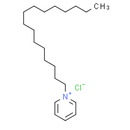Description
Cetylpyridinium chloride, a cationic quaternary ammonium compound, is an anti-bacterial agent with broad-spectrum activity. Cetylpyridinium chloride is an effective anti-HBV capsid assembly inhibitor with an IC50 of 2.5 μM. Cetylpyridinium chloride is used in pesticides and various types of mouthwashes, and other personal care products.
Product information
CAS Number: 123-03-5
Molecular Weight: 339.99
Formula: C21H38ClN
Chemical Name: 1-hexadecylpyridin-1-ium chloride
Smiles: [Cl-].CCCCCCCCCCCCCCCC[N+]1C=CC=CC=1
InChiKey: YMKDRGPMQRFJGP-UHFFFAOYSA-M
InChi: InChI=1S/C21H38N.ClH/c1-2-3-4-5-6-7-8-9-10-11-12-13-14-16-19-22-20-17-15-18-21-22;/h15,17-18,20-21H,2-14,16,19H2,1H3;1H/q+1;/p-1
Technical Data
Appearance: Solid Power
Purity: ≥98% (or refer to the Certificate of Analysis)
Solubility: DMSO : 100 mg/mL (294.13 mM; Need ultrasonic).
Shipping Condition: Shipped under ambient temperature as non-hazardous chemical or refer to Certificate of Analysis
Storage Condition: Dry, dark and -20 oC for 1 year or refer to the Certificate of Analysis.
Shelf Life: ≥12 months if stored properly.
Stock Solution Storage: 0 - 4 oC for 1 month or refer to the Certificate of Analysis.
Drug Formulation: To be determined
HS Tariff Code: 382200
How to use
In Vitro:
Cetylpyridinium chloride interacts with dimeric viral nucleocapsid protein (known as core protein or HBcAg) specifically. Compared with other HBV inhibitors, Cetylpyridinium chloride achieves significantly better reduction of HBV particle number in HepG2.2.15 cell line. Cetylpyridinium chloride inhibits capsid assembly and leads to reduced HBV biogenesis. Cetylpyridinium chloride is a safe antimicrobial agent with broad-spectrum activity for preventing biofilm formation and gingivitis.
In Vivo:
Cetylpyridinium chloride (30 μg/kg; intramuscular injection; daily; for 3 days; male C57BL/6 mice) treatment inhibits HBV replication in mouse hydrodynamic model system.
References:
- Hyun Wook Seo, et al. Cetylpyridinium chloride interaction with the hepatitis B virus core protein inhibits capsid assembly. Virus Res. 2019 Apr 2;263:102-111.
- Hiroto Imai, et al. Cetylpyridinium chloride at sublethal levels increases the susceptibility of rat thymic lymphocytes to oxidative stress. Chemosphere. 2017 Mar;170:118-123.
Products are for research use only. Not for human use.
Payment & Security
Your payment information is processed securely. We do not store credit card details nor have access to your credit card information.


